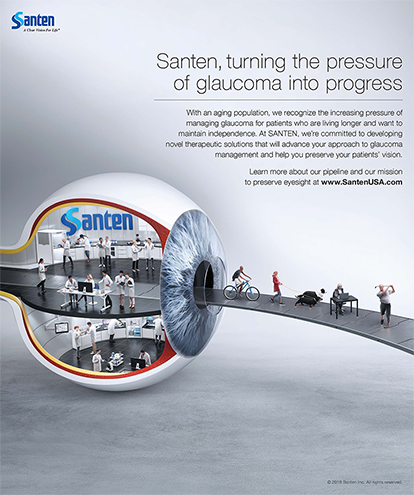Staying up to date on diagnostic technology elevates your standing in the eyes of ophthalmologists and other MDs in your referral network, such as internal medicine doctors, endocrinologists, and neurologists. They recognize a commitment
to providing care at the highest level, which should be the goal of every medically oriented optometrist. So, what equipment should you have?
THE BARE MINIMUM
For those who provide mainly vision care services with minimal medical eye care, a binocular indirect ophthalmoscope and a Goldmann applanation tonometer are important tools beyond just the basics of a phoropter and a slit-lamp biomicroscope. I know some practitioners may prefer noncontact tonometry or other forms of IOP screening such as the Icare tonometer (Icare USA), but Goldmann tonometry is still the gold standard. Although in our practice, the iCare tonometer is our screening tool of choice, we perform Goldman tonometry on all glaucoma suspects, all glaucoma patients, and those with borderline IOP screening results. To round out the list, quality diagnostic lenses (eg, 78 D, 90 D, and 20 D) to evaluate the optic nerve and peripheral retina are also a must.
ADDITIONAL TOOLS FOR THE MEDICALLY MINDED
For those who manage a fair number of patients with diabetes—and for anyone interested in doing more on the medical side of eye care—it is essential to have a fundus camera and an OCT to assess and monitor changes in the macula and the optic nerve. Widefield imaging of the retina can also enhance diagnostic accuracy and documentation of disease. A visual field analyzer is also imperative to manage patients with diabetes and with glaucoma, and I would also suggest having a pachymeter as well, in order to measure central corneal thickness if your OCT doesn’t provide that capability.
Although our practice has an OCT angiography (OCTA) device and I find the technology clinically useful, it is also expensive, and there’s no additional reimbursement for doing OCTA as opposed to OCT. For many practices, the cost-benefit ratio simply may not warrant purchasing one of these devices. I should also note that modern technology is computer driven, and software upgrades are frequent. Unlike most other diagnostic instruments, such as retinal cameras, visual fields, and anterior segment cameras, OCT routinely requires software upgrades. As manufacturers stop servicing older models, you may be required to purchase a new piece of hardware every 7 to 10 years.
For anyone who manages a fair amount of anterior segment pathology, an anterior segment camera is extremely useful to document findings and monitor resolution, especially if more than one doctor in the practice may be involved in patient care. If you fit specialty contact lenses or just want to complete your diagnostic arsenal, a corneal topographer is also essential for patients with keratoconus or pellucid marginal degeneration and for pre- and postoperative LASIK patients.
If ocular surface disease and dry eye disease are prevalent in your patient population, it can be worthwhile to purchase equipment that can analyze tear film assays and detect inflammatory markers in the tear film. A meibography unit can also be extremely useful (and can make a big impression on patients) for examining the meibomian glands and diagnosing disease or disruption occurring under the surface of the eyelid.
LEASE OR PURCHASE?
When furnishing your practice with equipment, you may want to consider leasing some technology rather than buying it outright—especially if a device is expensive or you’re not yet sure that it will suit your needs or those of your patient base. A lease may be financially advantageous because in most cases you don’t have to worry about equipment maintenance or upgrades; instead, you pay the lease note every month. Many leasing agreements include a buyout for a dollar amount at the last payment, an arrangement that may increase a practice’s cash flow in the short term. There may be tax implications to consider as well, depending on the state in which you practice. Pay close attention to the terms of the financing agreement. If you are considering leasing a diagnostic instrument, I would encourage you to consult your certified public accountant to perform a quick analysis to determine what would be most financially advantageous for your practice.
THE BENEFIT OF BEING WELL EQUIPPED
eurologists and rheumatologists have sent patients to our practice for OCT scans and visual field testing because these colleagues know we have the technology and will share our findings with them. Early research has suggested that OCTA can be useful for diagnosing Alzheimer disease, Parkinson disease, and amyotrophic lateral sclerosis.1-3
If these findings hold true in larger studies, practices that have this technology may be able to use it to generate more referrals. My point is that it is important for your practice to strategically acquire diagnostic technology that enhances clinical care, and many of these cutting-edge innovations create great public relations opportunities to educate patients and engage other local specialists with whom you’d like to collaborate.
For example, in clinical trials several years ago, an injectable medication for multiple sclerosis began to show some association with macular edema. A neurology clinic in our area was a test site for the drug, so our practice made the neurologist in charge of the trial aware that we had OCT technology, and he referred patients in the trial to us for baseline screenings and for monitoring throughout the course of therapy. Even now that the trial has concluded, we continue to receive referrals from this neurology clinic for other conditions.
As mentioned above, it is also important to keep your patients informed about any new technology that your practice acquires. When patients are in your office, take the time to review the images with them so they see what you are able to do.
This reinforces the quality of care you’re providing and enhances patient compliance with prescribed therapy. Furthermore, patients will also likely refer friends and family members to your practice.

STAY IN THE KNOW AND ON THE CUTTING EDGE
A technology that I’m keeping in my sights is corneal confocal microscopy. It images corneal nerves, and, although it’s been around for a little while now, recent studies show that it can predict the risk of peripheral neuropathy in patients with type 1 diabetes.4,5 This quick, noninvasive technology is also showing early promise as a possible diagnostic tool for multiple sclerosis and is perhaps even more accurate than an MRI. At present, it is still somewhat costly, but further development should reduce the cost.
I expect that diagnostic tools will become more precise and will increase our ability to customize treatment plans for patients. Stay abreast of diagnostic technology developments to make the best decision on what to acquire for your practice in order to optimize patient care.
- Lahme L, Esser EL, Mihailovic N, et al. Evaluation of ocular perfusion in Alzheimer’s disease using optical coherence tomography angiography. J Alzheimers Dis. 2018;66(4):1745-1752.
- Kwapong WR, Ye H, Peng C, et al. Retinal microvascular impairment in the early stages of Parkinson’s disease. Invest Ophthalmol Vis Sci. 2018;59(10):4115-4122.
- Hübers A, Müller HP, Dreyhaupt J, et al. Retinal involvement in amyotrophic lateral sclerosis: a study with optical coherence tomography and diffusion tensor imaging. J Neural Transm (Vienna). 2016;123(3):281-287.
- Petropoulos IN, Green P, Chan AWS, et al. Corneal confocal microscopy detects neuropathy in patients with type 1 diabetes without retinopathy or microalbuminuria. PLoS One. 2015;10(4):e0123517.
- Lewis EJ, Perkins BA, Lovblom LE, Bazinet RP, Wolever TM, Bril V. Using in vivo corneal confocal microscopy to identify diabetic sensorimotor polyneuropathy risk profiles in patients with type 1 diabetes. BMJ Open Diabetes Res Care. 2017;5e000251.






